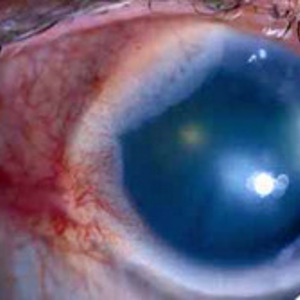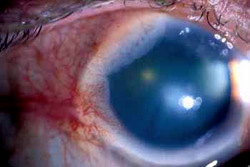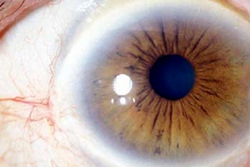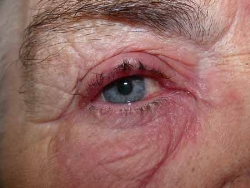Mitomycin C


Diffuse Dysplasia before MMC
Mitomycin C is a chemotherapy agent that is used to treat other forms of internal cancer elsewhere in the body. In yourself, it is only being used on the surface of the eye either to try and prevent the high risk of recurrence following surgical excision of localised non-invasive dysplastic lesions or as the sole treatment of more extensive or diffuse lesions. Mitomycin C is used in a drop form and kills the lesion by preventing division of the rapidly dividing tumour cells.
Dose

Dysplasia after MMC
The usual treatment regimen is one drop four times per day for one week. This is then repeated two or three more times with a week off between each of the courses. The week off allows for recovery of any healthy cells that may have been affected by the drops. You will be reviewed at the end of every week’s course.
Side Effects
Side effects are common and include redness, watering and irritation of the eye during the week of treatment, but these usually settle rapidly once the drops are stopped at the end of the week. Allergy to Mitomycin C is also common (one third of patients), and the eye and eyelids may become very red, swollen and itchy. Please notify the rooms during the day if this should occur. Significant pain is unusual and should be reported immediately.

Allergy
If you have a reaction to the Mitomycin C drops then other forms of chemotherapy drops may be substituted, for example 5FU or Interferon.
There have been no reported long term side effects to the eye following treatment with Mitomycin C.
There have been no reported side effects in other parts of the body following treatment of the eye with Mitomycin C.
Follow Up
If the drops are taken correctly, then the risk of the lesion recurring is close to zero. You will need to be reviewed 3 months following completion of the Mitomycin C treatment and then six monthly for a few years to monitor for the very small risk of recurrence of this lesion.
Rarely, recurrence of this lesion can give rise to cancer on the surface of the eye. It is vital that follow-up appointments are made before leaving after each visit. If you cannot make an appointment or miss a scheduled appointment, then it is important that you ring the rooms to make a new appointment.
